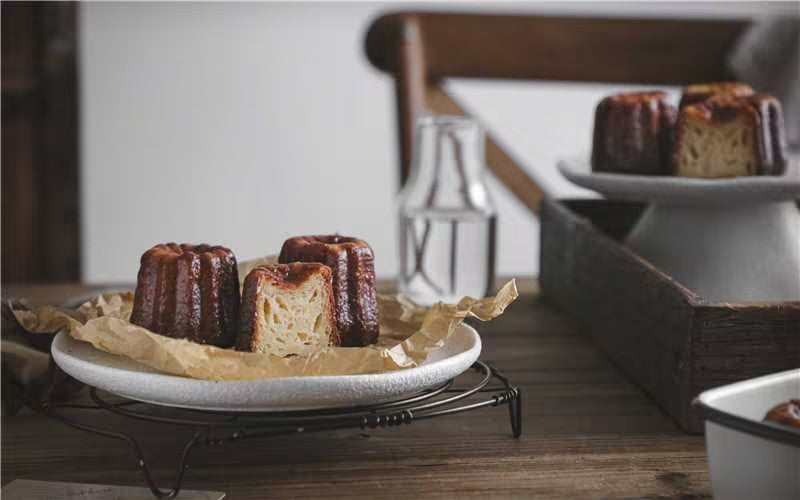
Teach you how to make cannele
Share
Freshly baked cannele is crispy on the outside and tender on the inside. The dark brown crispy shell is filled with a rich caramel aroma, and the fluffy and moist filling has exquisite honeycomb-shaped holes. The taste is rich in layers, and the aroma of rum and vanilla fills the mouth, making people don’t want to stop.
Cannele is a small French pastry with a super crunchy crust that contrasts beautifully with the pudding-like interior. Cannele is generally made from a combination of vanilla, rum, eggs, butter, sugar and flour. Making them is very challenging and requires patience, practice, focus and perseverance.
So how do we make so delicious and tempting cannele ourselves? Today’s article tells you about the choice of cannele mold and the recipe for making vanilla cannele~

Mold material selection
- Carbon Steel Mold|Best Choice
The cannele mold made of carbon steel has very good thermal conductivity and is recommended to those who want to make orthodox cannele. The material is strong and durable, allowing you to create professional-grade crouli that are crispy on the outside and chewy on the inside. CHEFMADE's cannele Mold Adopts thickened 0.8mm carbon steel to accelerate even heat. Strengthened edge is convenient to use. And the structure of our products avoid warping and ensure longer service life. CHEFMADE's cannele mold are coated with food-grade silicone, which does not release harmful substances at high temperatures and is PTFE and PFOA-free.(http://985.so/2cqhs)
- Stainless steel mold | Poor thermal conductivity, easy to stick to the mold
The characteristics of stainless steel cannele mold are that it is not easy to rust and is easy to maintain.
Iron molds are easy to rust and require timely maintenance. Stainless steel molds are relatively better.
However, the disadvantage of stainless steel is that it has poor thermal conductivity and is easy to stick on the mold. So if you are using a stainless steel mold, be sure to apply more butter or other release oil before pouring the batter.
- Aluminum mold|Poor durability and easy to deform
Aluminum molds are characterized by good thermal conductivity and high cost performance. Even novices can bake cannele with beautiful colors. Moreover, the aluminum mold is also suitable for refrigerated desserts and can be used in the production of jelly and pudding.
However, aluminum molds have poor durability and are easily deformed.
- Silicone mold|The material is soft and easy to deform when heated
The characteristic of silicone molds is that they can bake a large batch at a time, and the mold care is also simple. The price is cheap and the threshold is low for novices.
The disadvantage is that the mold itself is very soft and will thermally expand when baked. Therefore, the batter should not be poured too full.
Select mold size and quantity
Cannele made with a large mold has more moist and soft parts inside. On the other hand, Koruri made with a small mold has more hard and crispy skin. Moreover, the large-sized Koruri tastes chewy enough, and the small-sized Koruri is fun to eat one bite at a time. The size and quantity you make depends on your goals.
The dimensions and quantities of CHEFMADE’s cannele molds have been organized below:
CANNELE MOLD 6 WELL(http://985.so/2cquy)
CANNELE MOLD 12 WELL(http://985.so/2cquj)
MINI CANNELE MOLD 12 WELL(http://985.so/2cqu0)
MINI CANNELE MOLD 20 WELL(http://985.so/2cqrw)
Buy according to your needs~

Here is a recipe for making cannele:
【Vanilla cannele】
- Tools
- Ingredients
Milk ............................................................640g
Fine sugar .........................................................170g
Whole egg liquid................................................ 40g
Egg yolk liquid....................................................30g
Rum .......................................................... 30g
Vanilla paste........................................................15g
Low gluten flour................................................160g
(This recipe can make 12)
- Steps
No.2 | Pour milk and granulated sugar into the pot, boil over low heat until small bubbles appear, then turn off the heat
No.3 | Add the butter prepared in advance, melt the butter with the remaining heat of the milk, and then stir evenly
No.4 | Sift low-gluten flour into the basin
No.5 | Pour the milk butter liquid (warm state) into the flour and stir while pouring it in
No.6 | At this time, the batter is still warm. Pour in the whole egg liquid and egg yolk liquid, and stir evenly while pouring.
No.7 | Then sift it and use a scraper to scrape off the flour while sifting.
No.8 | Pour rum and vanilla paste into the sieved batter and stir evenly
No.9 | Cover with plastic wrap and refrigerate for 48 hours
No.10 | After refrigeration, take out the batter and use egg beater to stir evenly
No.11 | Brush the mold with a thin layer of butter, then pour the batter into it until it is 90% full.
No.12 | Place in the middle rack of the preheated oven and bake at 220 degrees for 20 minutes.
No.13 | After the first baking time is completed, turn the heat up and down and bake at 180 degrees for about 45 minutes.
No.14 | When the baking surface is dark, you can take it out of the oven. Turn it upside down on a drying net and let it cool.

